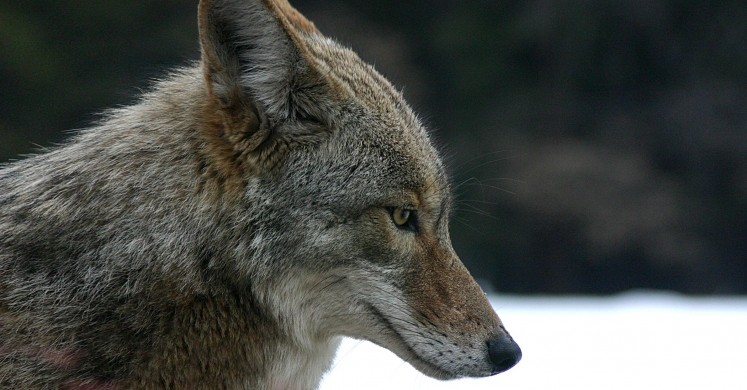Blog

#bioPGH Blog: Oh Deer, a Coyote!
 A resource of Biophilia: Pittsburgh, #bioPGH is a weekly blog and social media series that aims to encourage both children and adults to reconnect with nature and enjoy what each of our distinctive seasons has to offer.
A resource of Biophilia: Pittsburgh, #bioPGH is a weekly blog and social media series that aims to encourage both children and adults to reconnect with nature and enjoy what each of our distinctive seasons has to offer.
The footprints in the snow looked like those of a medium-sized dog, but the motion-activated camera a few feet away had often captured what humans in the area rarely saw—coyotes. This private property in Hampton Township is not far from Route 8 and it is nearly surrounded by developed neighborhoods, yet the enigmatic coyote was there in the midst of all the activity, just simply unseen. Let’s uncover a bit more about these secretive canid neighbors, shall we!
Though we rarely actually see coyotes ourselves, it is very likely that they are all around Pittsburgh. By Game Commission estimates, Pennsylvania is roughly at capacity for coyotes based on habitat analyses. The trouble is that coyotes are elusive and adapt to habitats so well, it is difficult to properly estimate population size. Coyotes have managed to adapt to rural farmland, suburban neighborhoods, and even highly urbanized cities. These reserved canines aren’t a real problem to humans, though. Odds are, we have walked by them without even realizing it.
Intriguingly, though fossil evidence suggests some sort of coyote presence in eastern North America since the Pleistocene, the last few centuries of Pennsylvania’s history did not include coyotes. Rather, the last hundred years proved to be a time of range expansion for the elusive canids. It appears that in the early twentieth century, coyotes from the northern Midwest traveled into Canada, above the Great Lakes, and then made their way down to the eastern US through New York State into Pennsylvania. Around the same time, coyotes from more southern Midwestern grassland also began traveling east via Illinois, Indiana, and Ohio, finally stretching into PA
This expansion is hypothesized to be a part of why our coyotes are hybrids with wolves. When western coyotes began expanding eastward over a century ago—possibly due to pressure from human activity—the coyotes mixed with declining numbers of wolves in eastern North America. Recent genetic studies suggest that it seems especially likely that male wolves (and domestic dogs!) have crossed with female coyotes, but different areas across the east show varying degrees of hybridization.
Even with hybridization with wolves, species concepts are tricky, and all US coyotes are still considered one species, Canis latrans. However, coyotes in the eastern and western US exhibit a range of physical and behavioral characteristics that seem to follow a geographic gradient. Overall, when compared to the western coyote, the eastern coyote is larger, weighing in at 35-55 pounds as opposed to 20-40 pounds; and the eastern coyote often has more gray than brown in its pelt. The two also exhibit some behavioral differences in hunting style and social structure. In addition, though the western coyote was adapted primarily for life as a small mammal predator on the Great Plains, our eastern coyote has the potential to occasionally manage larger prey (even deer!) due to its overall larger size.
Knowing that these cool creatures are around us is fascinating, but just in case you were concerned, there is little need to worry about coyotes. They generally don’t want to run into us. If you do happen to spot one, just slowly back away, and perhaps make noise or make yourself seem bigger with a jacket as you back away. Small pets shouldn’t be left alone outside overnight anyway, but do keep an eye them if you know there are coyotes in the area.
Connecting to the Outdoors Tip: Biodiversity is exciting! If you’d like to look for signs of coyotes, check out this guide from the Urban Coyote Research Group. It will help you identify tracks and scat plus give you an idea of vocalizations to listen for.
Continue the Conversation: Share your nature discoveries with our community by posting to Twitter and Instagram with hashtag #bioPGH, and R.S.V.P. to attend our next Biophilia: Pittsburgh meeting.
Additional Resources
USDA-APHIS: What Do We Know – A Literature Review of the Eastern Coyote
Post-Gazette: “Coyotes are ‘everywhere’ in Pennsylvania, but they pose little threat to humans.”
Pennsylvania Game Commission: Eastern Coyote
Houben 2004: Status and Management of Coyote Depredations in the Eastern United States
Kays et al. 2009: Rapid adaptive evolution of northeastern coyotes via hybridization with wolves
Wheeldon et al. 2010: Colonization history and ancestry of northeastern coyotes

